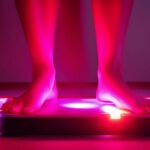Eczema is a chronic skin condition that affects a large number of people worldwide. One of the treatments for eczema is light therapy, which involves exposing the skin to specific wavelengths of light. In this essay, we will explore the use of light therapy as a treatment for eczema, including its benefits, risks, and effectiveness.
Understanding Eczema
Eczema is a chronic skin condition that affects millions of people worldwide. It is characterized by red, itchy, and inflamed skin patches that can be painful and uncomfortable. Eczema can occur anywhere on the body, including the face, neck, hands, and feet. While the exact cause of eczema is unknown, it is believed to be linked to genetics, environmental factors, and a weakened immune system.
Different Types of Eczema
There are several types of eczema, including atopic dermatitis, contact dermatitis, nummular eczema, and seborrheic dermatitis. Atopic dermatitis is the most common type and is often associated with allergies and asthma. Contact dermatitis is caused by contact with an irritant or allergen, while nummular eczema is characterized by circular patches of dry, itchy skin. Seborrheic dermatitis typically affects the scalp, face, and ears and is often associated with dandruff.
Traditional Treatments for Eczema
There are several traditional treatments for eczema, including topical creams, oral medications, and light therapy. Topical creams, such as corticosteroids, can reduce inflammation and itching, while oral medications, such as antihistamines, can help relieve itching and improve sleep. Light therapy, also known as phototherapy, is a non-invasive treatment that uses ultraviolet light to reduce inflammation and improve skin health.
Key Takeaway: Light therapy is a safe and effective treatment option for those suffering from eczema. It can help reduce inflammation, improve skin health, and increase Vitamin D production. However, there are some risks and side effects, such as skin irritation and increased risk of skin cancer, that patients should be aware of before undergoing light therapy treatment.
How Light Therapy Works
Light therapy works by exposing the skin to specific wavelengths of light, which can penetrate deep into the skin’s layers. This exposure can help reduce inflammation, promote healing, and improve skin health. Light therapy can be delivered through a light box, which is a device that emits specific wavelengths of light, or through natural sunlight.
The Benefits of Light Therapy on Eczema
Light therapy is a safe and effective treatment option for eczema, with several benefits for patients. Here are some of the ways light therapy can help with eczema:
One key takeaway from this text is that light therapy is a safe and effective treatment option for eczema that offers several benefits for patients. By reducing inflammation, promoting healing, improving skin health, increasing vitamin D production, and being a non-invasive treatment, light therapy is a viable alternative to traditional treatments such as oral medications and topical creams. However, patients should also be aware of the risks and side effects associated with light therapy, such as skin irritation, increased risk of skin cancer, eye damage, and photosensitivity. They should consult with their doctor about the risks and benefits of light therapy and how to reduce the risk of potential side effects.
Reduced Inflammation
Light therapy can help reduce inflammation in the skin, which is a common symptom of eczema. By reducing inflammation, patients may experience less redness, itching, and discomfort.
Improved Skin Health
Light therapy can improve overall skin health by promoting the production of collagen and elastin, which can help improve the skin’s elasticity and texture. This can lead to smoother, healthier-looking skin.
Increased Vitamin D Production
Light therapy can also increase the production of vitamin D in the skin, which is essential for overall health and well-being. Vitamin D can help regulate the immune system and reduce inflammation, which can be beneficial for patients with eczema.
Non-invasive Treatment
Light therapy is a non-invasive treatment option for eczema, which means that patients do not have to undergo surgery or take oral medications. This can be beneficial for patients who prefer natural treatment options or who want to avoid the side effects of traditional medications.
Risks and Side Effects
While light therapy is generally safe and well-tolerated, there are some risks and side effects to be aware of. These include:
Skin Irritation
Some patients may experience skin irritation or redness after light therapy treatment. This is typically mild and can be treated with topical creams or ointments.
Increased Risk of Skin Cancer
Exposure to ultraviolet light can increase the risk of skin cancer, especially with long-term or frequent exposure. Patients should speak with their doctor about the risks and benefits of light therapy and how to reduce the risk of skin cancer.
Eye Damage
Exposure to ultraviolet light can also cause eye damage, including cataracts and macular degeneration. Patients should wear protective eyewear during light therapy treatment.
Affordable Treatment
Light therapy is an affordable treatment option for eczema. While the initial cost of a light box may be high, the long-term cost of using light therapy is relatively low compared to other treatments, such as oral medications or topical creams.
Photosensitivity
Some medications and skincare products can increase photosensitivity, making patients more susceptible to skin damage from light therapy. Patients should speak with their doctor about any medications or skincare products they are using before undergoing light therapy treatment.
FAQs – Light Therapy on Eczema
What is light therapy for eczema?
Light therapy, also known as phototherapy, is a treatment that uses specific wavelengths of light to reduce inflammation and improve skin conditions such as eczema. This therapy involves exposing the affected skin to UV light or other specific wavelengths of light to eliminate bacteria and reduce inflammation. It is mainly used to treat inflammation and itching caused by eczema.
What are the different types of light therapy available for eczema?
Broadband UVB, Narrowband UVB, UVA, and PUVA are the four types of light therapy available for eczema. Broadband UVB uses a broader range of wavelengths to treat eczema, while Narrowband UVB uses a narrower range of wavelengths to target the affected skin. Meanwhile, UVA and PUVA use a combination of UVA and a photosensitizer to treat eczema. The choice of treatment will depend on the type and severity of eczema, as well as the patient’s skin type.
Can light therapy completely cure eczema?
Unfortunately, light therapy cannot completely cure eczema, but it can significantly reduce symptoms. Through light therapy, inflammation, itching, and other symptoms of eczema can be reduced, helping patients find relief from their condition. However, it is important to understand that eczema is a chronic condition that may require long-term management and treatment.
Is light therapy safe for everyone?
Light therapy is generally considered safe for most patients. However, it may not be suitable for pregnant women, individuals with a history of skin cancer or who are taking certain medications that make the skin more sensitive to light. Therefore, it is important to consult with a healthcare professional before undergoing light therapy treatment.
What are the side effects of light therapy for eczema?
The most common side effect of light therapy for eczema is skin dryness or redness, and this can be managed with appropriate moisturization. Other side effects may include mild itching or burning sensations, which can be mitigated by adjusting the intensity or duration of treatment. Other side effects may include tanning or sunburn.
How long does each session of light therapy take?
The duration of each session of light therapy can vary depending on the type of treatment and the severity of the condition. Broadband UVB therapy usually lasts between 1 to 3 minutes per session, while narrowband UVB may last from a few seconds to a few minutes. Meanwhile, UVA and PUVA treatment sessions may last longer, typically between 10 to 30 minutes. Consult with a healthcare professional to determine the right duration and frequency for your individual condition.
How quickly can I see the results of light therapy for eczema?
The results of light therapy for eczema vary between individuals, with some experiencing improvements in symptoms within a few weeks, while others may require several sessions to see results. However, many patients may experience a significant improvement in their eczema symptoms after 10 to 20 sessions of light therapy. It is essential to follow the treatment plan recommended by a healthcare professional for the best possible results.


.jpg)




